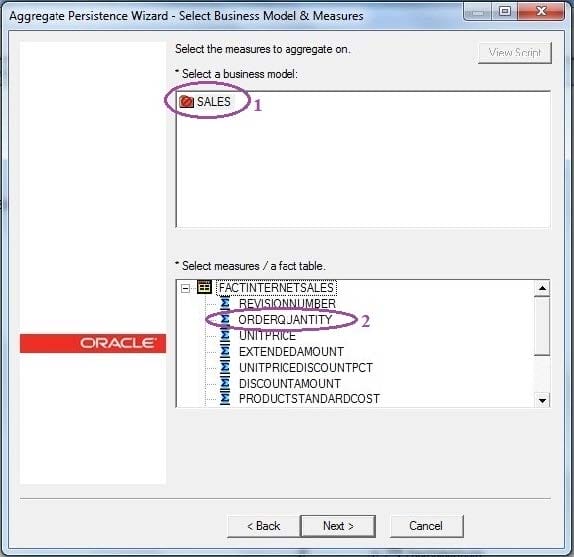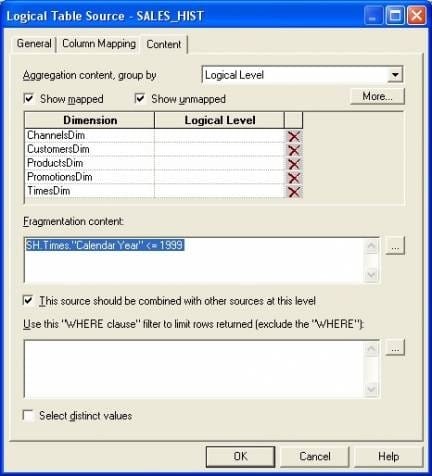Exam Details
Exam Code
:1Z0-591Exam Name
:Oracle Business Intelligence Foundation Suite 11g EssentialsCertification
:Oracle CertificationsVendor
:OracleTotal Questions
:120 Q&AsLast Updated
:Mar 26, 2025
Oracle Oracle Certifications 1Z0-591 Questions & Answers
-
Question 31:
Identify the correct mode to use when opening the web catalog while performing security settings modifications and migrations.
A. Online
B. Offline
C. Managed
D. UnManaged
-
Question 32:
Which component is responsible for determining the device that receives the alerts for a given user account?
A. Dashboard
B. iBot
C. Alerts
D. Delivery Profiles
-
Question 33:
The three metadata layers are an important concept of the BI Server. Which statement is incorrect?
A. The physical layer defines the objects and relationships that the Oracle BI Server needs to write native queries against each physical data source.
B. Separating the logical of the application from the physical model provides the ability to federate multiple physical sources to the same logical object.
C. The model and mapping layer define the business or logical model of the data. This layer determines the analytic behavior seen by users.
D. The presentation layer defines the relationship that is needed to create the DML.
-
Question 34:
Which two options are included in Oracle BI Server cache management techniques?
A. Using NQSConfig.ini to manually edit the parameters
B. Scheduling Server password
C. Maximum Number of Rows to Download to Excel
D. Inspecting the cache reports
E. Manage access to Subject Areas
-
Question 35:
To add multiple sources to on existing logical table dimension in the Business Model and Mapping layer, the source of the data must first exist in which option?
A. Presentation Layer
B. Business Aggregate Layer
C. Physical Layer
D. Web Catalog
-
Question 36:
A customer wants to analyze the efficiency of his/her order fulfillment process. If the customer has a dimensional model, which option is the fact table?
A. Stores
B. Orders
C. Products
D. Time
-
Question 37:
What is the first step when creating an Aggregate table in the OBI repository?
A. Test the Aggregate table by using Analysis
B. Specify the Fact table that you want to aggregate
C. Use Job Manager to run the Aggregate script
D. Create a dedicated Connection Pool
-
Question 38:
Where is Oracle Mapviewer installed?
A. In the same domain as OBIEE on the web application server
B. Never on the same domain as OBIEE on the web application server
C. On the Database server
D. On its own application server
-
Question 39:
When adding a new dimension to an existing logical table, what is the significance of the Logical Level setting in the Logical Table Source properties?
A. It defines the granularity of the dimension.
B. It determines the actual value of the dimension.
C. It creates a new session variable.
D. It creates a foreign key relationship.
-
Question 40:
If Security attributes conflict, what happens?
A. The user or application role is granted the minimum security attribute
B. The user or application role is granted the maximum security attribute
C. The user or application role is granted No security attribute
D. The user or application role is granted the Fully Restrictive security attribute
Related Exams:
1Z0-020
Oracle8i: New Features for Administrators1Z0-023
Architecture and Administration1Z0-024
Performance Tuning1Z0-025
Backup and Recovery1Z0-026
Network Administration1Z0-034
Upgrade Oracle9i/10g OCA to Oracle Database OCP1Z0-036
Managing Oracle9i on Linux1Z0-041
Oracle Database 10g: DBA Assessment1Z0-052
Oracle Database 11g: Administration Workshop I1Z0-053
Oracle Database 11g: Administration II
Tips on How to Prepare for the Exams
Nowadays, the certification exams become more and more important and required by more and more enterprises when applying for a job. But how to prepare for the exam effectively? How to prepare for the exam in a short time with less efforts? How to get a ideal result and how to find the most reliable resources? Here on Vcedump.com, you will find all the answers. Vcedump.com provide not only Oracle exam questions, answers and explanations but also complete assistance on your exam preparation and certification application. If you are confused on your 1Z0-591 exam preparations and Oracle certification application, do not hesitate to visit our Vcedump.com to find your solutions here.

